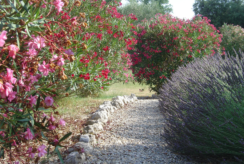 This flowering woody perennial is well-loved for its colourful panicles of purple flowers that appear in early spring and is named after its native home of origin, the island of Madeira in the Canary Islands. Pride of Madeira is a flowering shrub rather than a perennial with dieback growth, but it is biennial, so it only flowers every other year.
This flowering woody perennial is well-loved for its colourful panicles of purple flowers that appear in early spring and is named after its native home of origin, the island of Madeira in the Canary Islands. Pride of Madeira is a flowering shrub rather than a perennial with dieback growth, but it is biennial, so it only flowers every other year.
This plant has sturdy woody stems, slender grey-green spiky leaves, and a cone-shaped flower panicle at the end that bears many tiny flowers, similar to butterfly bush/buddleia flowers.
Pride of Madeira has a mounding, low-branching habit and can grow quite large, reaching up to 8 feet tall and 10 feet wide, making it a dramatic landscape specimen with a real visual impact in the garden. Plant pride of Madeira seeds after the last frost in early spring. This plant’s bright purple-blue flowers bloom for several weeks, making it a stunning specimen in the perennial garden.
Light
This plant thrives in full sun and prefers a sunny location with at least six hours of direct sunlight per day. Partial sun locations are acceptable, but afternoon sun is preferable to morning sun because the light intensity is higher at that time.
Pride of Madeira is not picky about soil, but it does require good drainage. It is adaptable to a wide range of soil conditions, including clay, sand, and loam, as well as a wide range of pH levels. Given its island origins, this shrub is also particularly salt-tolerant, making it an excellent plant for coastal landscaping.
Water Pride of Madeira is drought resistant. If you notice the flower heads drooping in hot weather or the foliage drying out, water the shrub at the base to revive it. In general, watering regularly during the flowering season will keep the blooms bright and vibrant.
 Humidity and temperature
Humidity and temperature
The pride of Madeira shrub will not thrive in temperatures consistently below 50 degrees Fahrenheit—its hardiness is limited to a very narrow window, and it will not survive temperatures below freezing. In the event of an unseasonable drop in temperature, it should be protected and covered with a frost blanket.
It enjoys the humid ocean air because it is a coastal plant, but it does not require special humidity conditions in gardens unless planted in a desert climate. This shrub may require misting from time to time in the desert air to keep its leaves and flowers looking vibrant.
Pruning
Spent flower stalks should be removed on a regular basis to keep the shrub looking tidy and to encourage new growth. Branches and stems that are dead or damaged should be pruned throughout the season. Light pruning in the summer will also help keep the foliage of this plant full.




